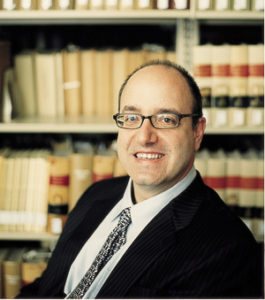From the Dean

This issue of Stanford Lawyer looks at criminal law. It ’s an area of real strength at SLS. We have top scholars in the field, and offer a wide selection of courses. The Stanford Criminal Justice Center, co-directed by Bob Weisberg and Joan Petersilia, does cutting-edge research on criminal and penal policy. And two clinics—one focusing on defense, the other on prosecution—give students an opportunity to take what they learn in classes and from research and apply it in real-world settings. Students interested in criminal law and justice can thus experience the full range of learning situations needed to launch a successful career: classes, research, and experiential learning. It’s a model of legal education we are implementing across the curriculum—from business law to intellectual property law to environmental law, international law, and more—replacing the unguided, haphazard curriculum of the past with opportunities for structured immersion in the array of experiences needed to train great lawyers. • This idea of a guided and structured curriculum is no small matter. Advice on what to do while in law school has long been scarce—not just at Stanford but everywhere. Most of us were told that it didn’t matter much what courses we took, that we should just look on our time in law school as an opportunity to do a sort of “liberal arts in law” degree. We could figure out what kind of lawyer we wanted to be later, after we graduated and joined a law firm. The firms, in turn, cooperated by letting new lawyers experiment with different practice groups for a few years—creating what amounted to a de facto apprenticeship. • Nor did students need much guidance, even if they knew what they wanted to do. Law school curricula were spare, and opportunities outside the law school were limited. If a student said he or she wanted to become a corporate lawyer and asked what courses to take, the answer was simple: Take the classes in corporate law.
This laissez-faire approach is unacceptable today. Practice has become more complicated and specialized, and 21st century lawyers need more than basic knowledge of legal doctrine and analysis to succeed. This need for more arose, unfortunately, just as the implicit law firm-apprenticeship was breaking down—a victim of economic pressure and the reluctance of clients to subsidize training costs. The law school curriculum, in the meantime, has blossomed, presenting students with many more choices of things to study. This is particularly true at SLS, where these changes in the profession motivated an overhaul of the second- and third-year curricula that included changing our academic calendar, easing access to courses outside the law school, and adding new clinics, joint degrees, problem-solving simulations, and more. With these reforms, the number of possible law courses has doubled and hundreds more relevant classes are now readily available in other parts of the university.
Such changes obligate us to do more to help students make good use of their time here. We need to help students begin to choose a direction and, as they focus, to develop appropriate skills and knowledge. As important, we need to ensure that students don’t miss opportunities or waste their time for lack of information and advice. Recognizing this responsibility, we have beefed up our career services offices, launched new student/faculty mentoring programs, and created SLSConnect to bring alumni into the advising process.
This month, we will roll out the latest innovation in our effort to help students define their professional goals and make optimal use of the law school and wider university in achieving those goals. Called “SLSNavigator,” it is an online tool that enables students to explore career possibilities, discover the skills and knowledge lawyers in different fields need, and find relevant courses and other resources. Students can choose different kinds of practice (transactional, litigation, policy, etc.) and different areas of interest (business law, health law, environmental law, etc.) and learn what lawyers in such practices require and where in the university to find it. SLSNavigator identifies foundational courses, key electives, and related courses. It describes how these courses are relevant to a given career path, as well as indicating other career paths for which the course is also relevant. It offers advice on resources students can consult to learn more—blogs, journals, etc. More than 1,500 courses and 20,000 discrete pieces of information are organized and made accessible on SLSNavigator. And these numbers will continue to grow as more information is added. But this new tool is meant to supplement, not replace, existing advising systems. We want students to browse and explore and use the results to initiate conversations with faculty or career advisors—or with alumni contacted via SLSConnect.
I mention all this partly to boast: SLSNavigator is a product of more than two years of intensive labor—and nothing remotely like it is available elsewhere. More important, we need your participation, for we want SLSNavigator to be accurate and stay fresh—to be “evergreen” so to speak. It is thus set up to make feedback easy. So go to slsnavigator.law.stanford.edu, request a login, take a spin, and share your thoughts.
